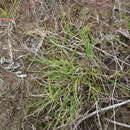Description
provided by eFloras
Plants densely cespitose; rhizomes short. Culms often slightly curved, weak, 2–10 cm. Leaves: sheaths pale to mid brown abaxially, loose, inner band white-hyaline, concave at summit; ligules shorter than wide; blades usually pale to gray-green, flat at base, involute distally, 1–5 cm × 0.5–1.5 mm, exceeding culms. Inflorescences 0.4–1 cm × 3–6 mm; bracts inconspicuous, shorter than spikes. Spike 1(–2), gynecandrous, closely approximate, containing 7–15 perigynia, obovoid or suborbicular, 4–7 × 4 mm. Pistillate scales chestnut-brown with lighter center and very narrow hyaline margins, broadly ovate, subequal to perigynia, apex obtuse. Perigynia closely appressed, gray-brown to pale or mid brown, lightly or obscurely several-veined, ovate, 1.5–2 × 1.25 mm, widest near middle, subcoriaceous; beak short, entire. Achenes red-brown, obovate, 1.2 × 0.7–1 mm, dull to slightly glossy. 2n = 64.
- license
- cc-by-nc-sa-3.0
- copyright
- Missouri Botanical Garden, 4344 Shaw Boulevard, St. Louis, MO, 63110 USA
Distribution
provided by eFloras
Greenland; Man., N.W.T., Nunavut, Que., Yukon; Alaska; Eurasia.
- license
- cc-by-nc-sa-3.0
- copyright
- Missouri Botanical Garden, 4344 Shaw Boulevard, St. Louis, MO, 63110 USA
Habitat
provided by eFloras
Sandy, gravelly seashores in Arctic; 0–10m.
- license
- cc-by-nc-sa-3.0
- copyright
- Missouri Botanical Garden, 4344 Shaw Boulevard, St. Louis, MO, 63110 USA
Comprehensive Description
provided by North American Flora
Carex ursina Dewey, Am. Jour. Sei. 27: 240 pi. U,f.68. 1835.
"'Carex glareosa Wahl." Malmgr. Oefv. Sv. Vet.-Akad. Forh. 19: 251. 1862. Carex glareosa var. (3. Boott, 111. Carex 153. pi. 494, f. 5, 6. 1867. (Based on C. ursina Dewey.) Carex glareosa var. caespilosa Bock. Linnaea 30: 76. 1875. (Type from Kamchatka.) Carex glareosa var. ursina L. H. Bailey, Cat. N. Am. Car. 3. 1884. (Based on C. ursina Dewey.)
Loosely cespitose, in small clumps, the rootstocks much bunched, slender, brownish, the culms 2-6 cm. high, very low, erect or slightly curving, slender, about equaling or hidden among the leaves, smooth, bluntly triangular, brown at base and clothed with the dried-up leaves of the previous year, the lowest bladeless; leaves with well-developed blades usually 4-8 to a fertile culm, clustered near the base, the blades flat at base, involute above, lightor glaucous-green, stiffish, 1-3 cm. long, 0.75-1.5 mm. wide, roughened towards the attenuate apex, the sheaths tight, white-hyaline and thin ventrally, short-prolonged at mouth beyond base of blade and continuous with ligule; spike usually solitary, obovoid or suborbicular, 4-7 mm. long, 4 mm. wide, gynaecandrous, obtuse at apex, rounded or more or less shortclavate at base, containing 7-15 closely appressed perigynia above and the inconspicuous stamina te flowers beneath; bract absent; scales broadly ovate or broadly oblong-ovate, obtuse, chestnut-brown with very narrow hyaline margins and lighter center, thin and rounded, the midvein not extending to tip, as wide as but shorter than perigynia; perigynia plano-convex, thickish, ovate, 2 mm. long, 1.25 mm. wide, slightly sharp-angled, but not at all margined, glaucous, yellowish, membranaceous, densely white-punctate, finely several-nerved dorsally, obscurely nerved ventrally, conspicuously stipitate, rounded at base, very abruptly contracted into a very minute beak scarcely 0.2 mm. long, smooth, obliquely cut and sutured dorsally, entire; achenes lenticular, small, closely filling perigynia, obovate, 1.5 mm. long, 1 mm. wide, short-stipitate, truncately apiculate; style short, slender, jointed with achene, at length deciduous; stigmas two, slender, yellowish-brown, rather short.
Type locality: "Found by Dr. Richardson on the seacoast of Arctic America." Distribution: Arctic seacoast from Greenland to Mackenzie; also in the extreme northern
- bibliographic citation
- Kenneth Kent Mackenzie. 1931. (POALES); CYPERACEAE; CARICEAE. North American flora. vol 18(2). New York Botanical Garden, New York, NY

